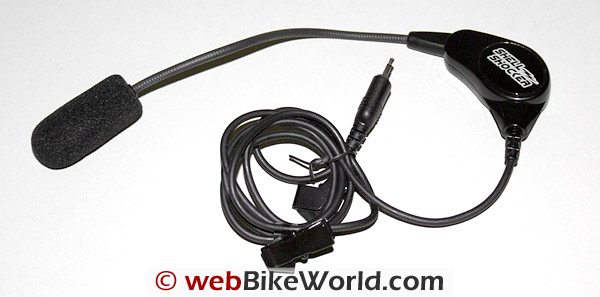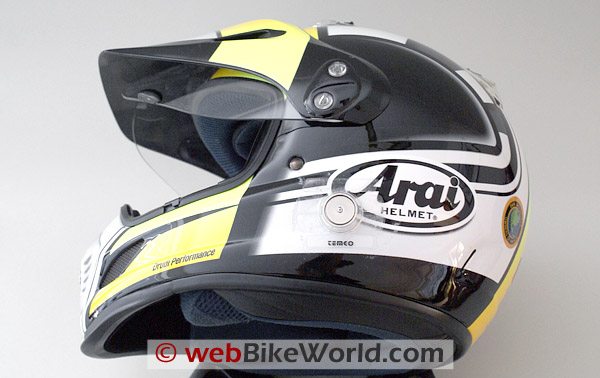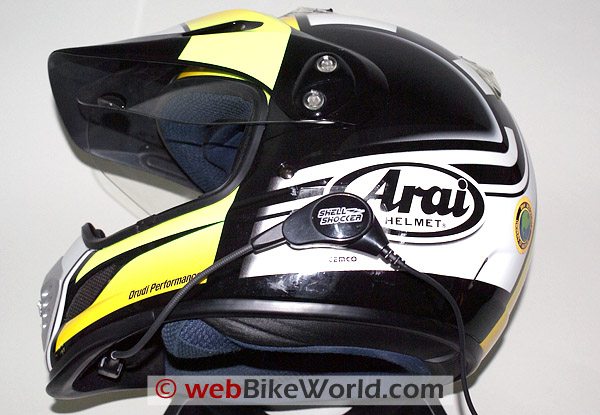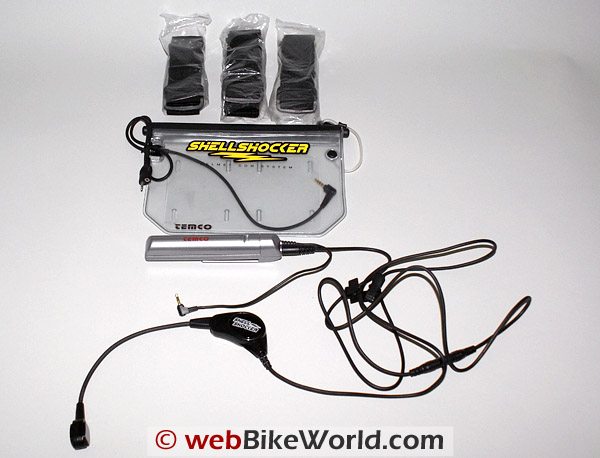Temco ShellShocker Motorcycle Microphone and Speaker System
A unique system that showcases sound engineering and simple design aesthetics. Very easy to install and use, the system uses the motorcycle helmet shell to conduct sound to the rider and a standard microphone for the rider to use to talk. Provides good sound and excellent audio when used with a mobile phone, in the right riding environment.
But the same features that provide its uniqueness may also be its weaknesses. The ShellShocker has potential not yet realized and as such may not yet be ready for motorcycling prime time. But with a few changes, it could be…
After what seemed a long wait for the mail system to cough up the goods, a plain brown box was delivered by our friendly postal delivery individual, an avid motorcyclist himself. In the box shipped north by the Editor was the Temco ShellShocker kit.
The first item observed in the well-packed box is a well-written Owner’s Instruction Manual, for the HCS-S3U/E and HCS-S4U/E models. Reflecting a measure of standards and quality control, the manual addresses the things we like to see: warnings and safety cautions, kit checklist, familiarization, installation, use, specifications, product support issues and, a warranty card.
While not a guaranteed thing, a well written manual can set the tone and, first impressions are important. The actual kit is comprised of a single earpiece headset and connection wire, a weatherproof pouch, the mounting base-plate, one amplifier unit with interface cable, three straps and, the manual.
A caution clearly highlighted in the manual identifies that the base-plate uses a powerful magnet and therefore it is essential that magnetic strip or chip-based cards be kept away from the base-plate.

The ShellShocker
The ShellShocker is designed, manufactured and marketed by Temco Japan Co. Ltd. The whole focus of the company is the application of bone conduction technology. Their first commercial product, the VOICEDUCER Ear Microphone, was marketed in 1987, so they have been around for some time.
With a name like ShellShocker, the system is sure to attract attention and raise questions at the same time…probably intended. In understanding the principles behind the system, the name makes more sense.
OK, class time: Sounds are vibrations – externally they reach our ears through the air, and internally through our bones and skin. The auditory nerve in our inner ear detects both types of vibratory motion as sound and reacts accordingly.
With the ShellShocker, the speaker mounts directly on the outer shell of the helmet via the magnetic baseplate and by conduction the entire helmet basically becomes the speaker.
Although the same principle is applied to pick up vocal cord vibrations so they can be converted into electric audio signals by a highly sensitive vibration sensor, this system uses a conventional boom microphone for audio input.
Bone conductive techniques and products have been around for a long time. But as technology and requirements evolve, the principle is being used for more and more applications across virtually every market and user segment. A lot of products being offered or coming on to the market are spin-offs from military requirements and vice versa.
Specifications
The ShellShocker components are well made and will likely stand up to heavy use. Sizing of components is pretty standard and everything can be mounted, or carried easily. The headset is 270 x 43 x 18mm or xx, while the Amplifier Unit is 137 x 20 x 33mm. The items weigh in at 82g (with baseplate) and 90g (with batteries) respectively.
Power is supplied by two AA batteries and any type can be used, depending on longevity desired. Keeping the amplifier batteries warm will always extend their life (please dispose of or recycle cells as appropriate!). Continuous use time is rated at ten (10) hours.
The VIBRAUDIO Driver has a frequency range of 300Hz to 3,000Hz (3KHz) and the microphone has a frequency range of 100Hz to 10,000Hz (10KHz), both sufficient for voice-based audio use.


Installation
The system is designed to be mounted on the left side of the helmet. The first step is to clean that side of the helmet thoroughly and then select an area directly over the left ear. Peel the backing sheet off the adhesive and affix the baseplate to the helmet.
For efficiencies it is important that all sections of the baseplate are completely in contact with the helmet. Ensuring a good contact can be guaranteed by applying strong, steady pressure on the base-plate for 30 seconds or so.
The VIBRAUDIO driver or headset is now attached to the baseplate by matching the key points of the two components and aligning or locking the notches of the driver and base-plate in position together.
With these components secured, the boom microphone assembly that forms part of the actual headset can be adjusted; a full-face helmet is said to provide the best system performance. Simply position the microphone in the centre of the chin-guard, with the grey face of the microphone directly in front of the mouth.
Time for power – open the amplifier unit battery lid by pushing it in the direction of the large engraved arrow. Install two AA batteries (not supplied) and press the lid closed until a click is heard.
With power installed, the amplifier unit can be connected to the helmet component via the supplied interface cable – the cord clips are repositioned by pinching the complete assembly and sliding them along the cord(s).
Finally, connect a mobile phone to the amplifier unit using the supplied interface cable, in this instance a 3-pin plug or, one compatible with a specific mobile phone. Although most North American mobile phones are 3-pin, some use a 4-pin plug. Most service providers and retailers have a wide-range of connection cables or adapters, but sometimes a little sleuthing is needed.


Simple is Good
To get everything going, slide the power switch to ON and confirm that the Green LED indicator is on. Make a telephone call using the connected mobile phone in normal fashion – the audio will be heard through the ShellShocker: tones indicating an incoming call will be heard this way as well.
If the phone is set for automatic answering, the incoming call will be received in the headset automatically. Adjusting the volume is done via the phone, as no volume control is provided by the ShellShocker.
When not using the device, the unit should be powered down to extend battery life. Just remember to change phone settings, if needed, when the ShellShocker is not in use.
With high hopes for the system in actual use, my bubble was burst fairly quickly, with weaknesses in the system revealed on the first ride. As designed for voice use, and factoring in limitations of the technique used, the headset frequency response range is really limited – 300Hz to 3KHz.
The microphone is a different matter – it is electrically driven and provides a frequency range of 100Hz to 10KHz – outgoing voice sessions were very clear.
When using the system just for voice communications, the audio is good, as long as the batteries are fresh and ambient noise levels are low, i.e., low-speed street or back-road activities. At higher speeds, such as on-ramp and highway venues, the audio is quickly overcome by environmental noise.
With no way to increase system volume except by increasing the volume of the attached mobile phone, which tends to further distort the audio, using the system can be frustrating. Once the batteries start falling off, usually after 4-6 hours, the limited frequency range of the headset becomes even more acute.
Conclusion
Around town so to speak, the ShellShocker, with simplicity of purpose, is a very useful device. The whole assembly is easily tucked into a pocket, or if without pockets, carried in the supplied waterproof pouch, or tucked somewhere…
However much as I wanted to really like the product (especially for its use of bone conduction, something familiar due to previous ‘work’ experience) as a mobile interface between the rider and the mobile phone, it needs work.
With some further engineering, possibly involving a larger or higher-powered VIBRAUDIO Driver, or if some further complexity was deemed appropriate, by adding a second, right-side assembly, and providing a system volume control…
The ShellShocker has potential and although its limitations could likely be lived with for some riding environments, its performance is not up to the standards required by most motorcyclists.

